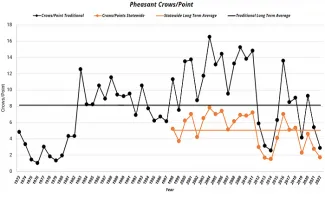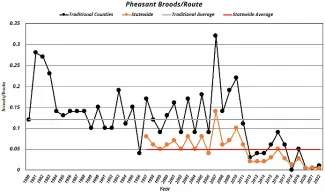2022 Ring-necked Pheasant Surveys and Pheasant Season Outlook
By Tell Judkins, Upland Game Biologist
Ring-necked pheasants remain a popular upland game species among Oklahoma hunters, with about 43,000 pheasants harvested in 2022. The Oklahoma Department of Wildlife Conservation monitors the pheasant population through two surveys; spring crow counts (Figure 2) and summer brood surveys (Figure 3). The data collected provides an index of the spring breeding population (crow counts) and recruitment success for that year (brood surveys).
Traditionally Alfalfa, Beaver, Cimarron, Grant, and Texas counties have had the highest pheasant numbers. These five counties have had spring crow surveys conducted since 1973, and brood surveys since 1980. In 1998, the surveys were expanded to 13 counties to include Ellis, Garfield, Harper, Kay, Major, Noble, Woods, and Woodward (Figure 1).
The spring 2022 crow count survey showed a lower number of calls heard per point than in 2021 (Figure 2). Looking at the numbers from 1973 to 2022, there is a positive trend in the number of calls heard during the spring crow call count surveys. The August brood surveys showed an increase over the past two years in the traditional counties but was slightly lower statewide (Figure 3). The five traditional counties were up from 0.005 in 2021 to 0.01 in 2022. However, the total number of pheasants observed was down from 36 in 2021 to 27 in 2022.
This past winter again saw several cold fronts and storms that brought potential for negative impacts, which were most likely more severe in areas of marginal habitat quality. The spring and summer saw flash drought across much of the state. Rainfall throughout spring and summer was sporadic, coming at times in monsoon-type storms rather than more normal systemic rains. Current conditions show that 99.7 percent of the state is experiencing at least moderate drought as of Nov. 15, with 64 percent of the state in extreme or exceptional drought (D3-D4).
Figure 4 below shows a comparison of drought levels in Oklahoma from March 8 to Oct. 18. When this report was prepared, all the pheasant range in Oklahoma was in at least moderate drought (D1), with over 99 percent in at least severe drought (D2). Figure 5 shows the departure from normal rainfall from May 26-Nov. 21, with areas up to 14 inches below normal rainfall. Too little rain can have just as much of an impact as too much rain. However, there were still reports coming in from people seeing three-fourths-grown birds.
Pheasant numbers this season will again most likely be patchy. Properties or areas where habitat is good for pheasants, insects are plentiful, forbs are abundant, and drought has not had a severe impact should hold a fair number of birds.
Pheasant hunting season opens Dec. 1, and runs through Jan. 31, 2023. Hunters may harvest two cock pheasants daily. Open areas include Alfalfa, Beaver, Cimarron, Garfield, Grant, Harper, Kay, Major, Noble, Osage, Texas, Woods, and Woodward counties; and the portions of Blaine, Dewey, Ellis, Kingfisher, and Logan counties north of State Highway 51. Seasons on public lands may vary from the statewide season. For complete regulations and more information, consult the Oklahoma Fishing and Hunting Regulations online at https://www.wildlifedepartment.com/hunting/regs, the Go Outdoors Oklahoma mobile app for Apple or Android, or in print wherever hunting and fishing licenses are sold.
Remember, the outdoors are always open! Work some ground, trust your dog, and make some memories!




